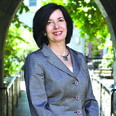By Sherri Kimmel
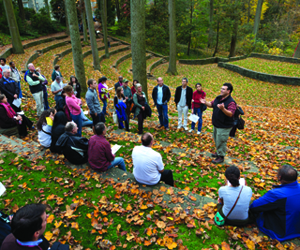
A year ago this fall, I stumbled around in the dusky light, making my way through trees neatly labeled. Paths crisscrossed, and I circled the campus trying to find the obscurely marked building where next day I would be interviewing for this job as magazine editor. I paused at the crest of Parrish Lawn and looked down Magill Walk, flanked by flame-orange trees.
Inhale, exhale.
I’d visited many college campuses but never encountered one so breathtaking, so neatly wedded to its natural setting. Could I picture myself here? It seemed almost too magnificent for me, a flatland-Ohio girl. But the leafy beauty drew me in, and my desire to portray this community in this place overcame my awe.
By Carol Brévart-Demm
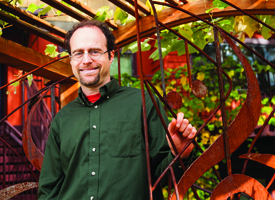
Imagine a rectangular plot of land, let’s say 100 by 75 feet. Four or so small row homes occupy part of the space. There’s also a building for common use, containing a living room where residents might chat, watch TV, peruse newspapers and magazines, or delve into a donated book from the shared library. A kitchen for the preparation of group meals as well as a bathroom and a spare bedroom for residents’ guests are available.
By Sherri Kimmel
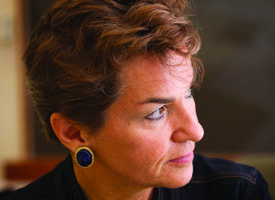
Just before, during, and after Hurricane Sandy hurled herself against the East Coast, frequent Twitterer Christiana Figueres ’79 was out in front with other “top people” (including Michael Bloomburg, Nicholas Kristof, and Al Gore) who use Twitter’s hash tag #Climatechange. “Makes severe weather events more frequent and more intense. What part of that do we not understand?” Figueres tweeted on Nov. 1.
By Carrie Compton
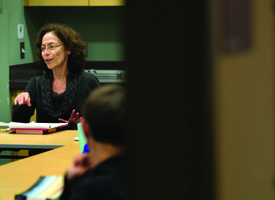
Draped in brightly colored saris, Indian women lean over troughs of acid, submerging discarded circuit boards shipped from the United States and other developed countries. Without protective gear, these women, and sometimes children, work day after day dipping the boards into vats of acid-based solution that removes silver and gold components from the e-waste.
By Susan Clarey
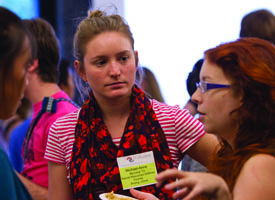
Half a world apart, Michael-Anne Myrvang ’13 and Dinah DeWald ’13 spent summer 2012 working toward the same goal: protecting the environment.
In New York City, DeWald signed on as an intern and activist with New Yorkers Against Fracking, an organization opposed to the controversial hydraulic fracturing technique used to extract petroleum and natural gas, including shale gas, from the earth.
“My job was very nimble,” she says. “I could be calling people to increase turnout to a rally, then the next minute putting up Facebook events and trying to boost our reach, then pulling together information for a press release we needed right away.
By Rebecca Chopp

One of my earliest memories is of my Grandfather Chopp, who lived his entire life on a 160-acre farm in north-central Kansas. He would hold me in his lap as he drove the tractor to churn up the soil. “We have to take good care of the land,” he often said. “Our lives depend upon it.”
During the hot, dusty days of summer, we also spent many hours walking across those fields, as he chopped the poisonous thistles that could kill the cows. He would point out the beauty of the single cottonwood tree, the vastness of the skies, and the scarcity of water in the small creek that trickled slowly through the farm.


To carry the burden of a chronic illness or learning disability during the college years is what I call The Fifth Course. The Fifth Course is more than a burden: It is both an imposed and possible learning opportunity. Fletcher Wortmann’s irreverent, funny, and sad chronicle of his time at Swarthmore College, before, during, and after his hospitalization for mental illness offers keen insight into The Fifth Course.
In this book we learn about the parallel worlds in which many of our students live—worlds in which the right T-shirt, self-mutilating girlfriend, prescribed medications, alcohol, misery poker, comedy troupe Boy Meets Tractor, Pokémon, and fear about acquiring AIDS make for a deeply unsettling combination alongside the usual rigorous four-course load at Swarthmore.
By Ed Ayres ’63
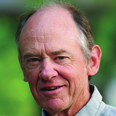
For the October 1966 Bulletin, three years after my graduation, I wrote an article with the whimsical title “What Are You Running in Your Underwear For?” It was not common to see people running along public roads in those days, and the bright athletic apparel we have now was not yet available in stores. All we had was our old gym shorts. But taunts from intoxicated young men in passing cars not withstanding, I wasn’t deterred from my pursuit of an activity that had become, for me, a great adventure.
 A year ago this fall, I stumbled around in the dusky light, making my way through trees neatly labeled. Paths crisscrossed, and I circled the campus trying to find the obscurely marked building where next day I would be interviewing for this job as magazine editor. I paused at the crest of Parrish Lawn and looked down Magill Walk, flanked by flame-orange trees.
Inhale, exhale.
I’d visited many college campuses but never encountered one so breathtaking, so neatly wedded to its natural setting. Could I picture myself here? It seemed almost too magnificent for me, a flatland-Ohio girl. But the leafy beauty drew me in, and my desire to portray this community in this place overcame my awe.
A year ago this fall, I stumbled around in the dusky light, making my way through trees neatly labeled. Paths crisscrossed, and I circled the campus trying to find the obscurely marked building where next day I would be interviewing for this job as magazine editor. I paused at the crest of Parrish Lawn and looked down Magill Walk, flanked by flame-orange trees.
Inhale, exhale.
I’d visited many college campuses but never encountered one so breathtaking, so neatly wedded to its natural setting. Could I picture myself here? It seemed almost too magnificent for me, a flatland-Ohio girl. But the leafy beauty drew me in, and my desire to portray this community in this place overcame my awe.  Imagine a rectangular plot of land, let’s say 100 by 75 feet. Four or so small row homes occupy part of the space. There’s also a building for common use, containing a living room where residents might chat, watch TV, peruse newspapers and magazines, or delve into a donated book from the shared library. A kitchen for the preparation of group meals as well as a bathroom and a spare bedroom for residents’ guests are available.
Imagine a rectangular plot of land, let’s say 100 by 75 feet. Four or so small row homes occupy part of the space. There’s also a building for common use, containing a living room where residents might chat, watch TV, peruse newspapers and magazines, or delve into a donated book from the shared library. A kitchen for the preparation of group meals as well as a bathroom and a spare bedroom for residents’ guests are available.  Just before, during, and after Hurricane Sandy hurled herself against the East Coast, frequent Twitterer Christiana Figueres ’79 was out in front with other “top people” (including Michael Bloomburg, Nicholas Kristof, and Al Gore) who use Twitter’s hash tag #Climatechange. “Makes severe weather events more frequent and more intense. What part of that do we not understand?” Figueres tweeted on Nov. 1.
Just before, during, and after Hurricane Sandy hurled herself against the East Coast, frequent Twitterer Christiana Figueres ’79 was out in front with other “top people” (including Michael Bloomburg, Nicholas Kristof, and Al Gore) who use Twitter’s hash tag #Climatechange. “Makes severe weather events more frequent and more intense. What part of that do we not understand?” Figueres tweeted on Nov. 1.  Draped in brightly colored saris, Indian women lean over troughs of acid, submerging discarded circuit boards shipped from the United States and other developed countries. Without protective gear, these women, and sometimes children, work day after day dipping the boards into vats of acid-based solution that removes silver and gold components from the e-waste.
Draped in brightly colored saris, Indian women lean over troughs of acid, submerging discarded circuit boards shipped from the United States and other developed countries. Without protective gear, these women, and sometimes children, work day after day dipping the boards into vats of acid-based solution that removes silver and gold components from the e-waste.  Half a world apart, Michael-Anne Myrvang ’13 and Dinah DeWald ’13 spent summer 2012 working toward the same goal: protecting the environment.
In New York City, DeWald signed on as an intern and activist with New Yorkers Against Fracking, an organization opposed to the controversial hydraulic fracturing technique used to extract petroleum and natural gas, including shale gas, from the earth.
“My job was very nimble,” she says. “I could be calling people to increase turnout to a rally, then the next minute putting up Facebook events and trying to boost our reach, then pulling together information for a press release we needed right away.
Half a world apart, Michael-Anne Myrvang ’13 and Dinah DeWald ’13 spent summer 2012 working toward the same goal: protecting the environment.
In New York City, DeWald signed on as an intern and activist with New Yorkers Against Fracking, an organization opposed to the controversial hydraulic fracturing technique used to extract petroleum and natural gas, including shale gas, from the earth.
“My job was very nimble,” she says. “I could be calling people to increase turnout to a rally, then the next minute putting up Facebook events and trying to boost our reach, then pulling together information for a press release we needed right away.  One of my earliest memories is of my Grandfather Chopp, who lived his entire life on a 160-acre farm in north-central Kansas. He would hold me in his lap as he drove the tractor to churn up the soil. “We have to take good care of the land,” he often said. “Our lives depend upon it.”
During the hot, dusty days of summer, we also spent many hours walking across those fields, as he chopped the poisonous thistles that could kill the cows. He would point out the beauty of the single cottonwood tree, the vastness of the skies, and the scarcity of water in the small creek that trickled slowly through the farm.
One of my earliest memories is of my Grandfather Chopp, who lived his entire life on a 160-acre farm in north-central Kansas. He would hold me in his lap as he drove the tractor to churn up the soil. “We have to take good care of the land,” he often said. “Our lives depend upon it.”
During the hot, dusty days of summer, we also spent many hours walking across those fields, as he chopped the poisonous thistles that could kill the cows. He would point out the beauty of the single cottonwood tree, the vastness of the skies, and the scarcity of water in the small creek that trickled slowly through the farm.

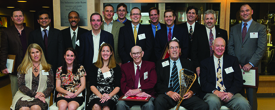
 To carry the burden of a chronic illness or learning disability during the college years is what I call The Fifth Course. The Fifth Course is more than a burden: It is both an imposed and possible learning opportunity. Fletcher Wortmann’s irreverent, funny, and sad chronicle of his time at Swarthmore College, before, during, and after his hospitalization for mental illness offers keen insight into The Fifth Course.
In this book we learn about the parallel worlds in which many of our students live—worlds in which the right T-shirt, self-mutilating girlfriend, prescribed medications, alcohol, misery poker, comedy troupe Boy Meets Tractor, Pokémon, and fear about acquiring AIDS make for a deeply unsettling combination alongside the usual rigorous four-course load at Swarthmore.
To carry the burden of a chronic illness or learning disability during the college years is what I call The Fifth Course. The Fifth Course is more than a burden: It is both an imposed and possible learning opportunity. Fletcher Wortmann’s irreverent, funny, and sad chronicle of his time at Swarthmore College, before, during, and after his hospitalization for mental illness offers keen insight into The Fifth Course.
In this book we learn about the parallel worlds in which many of our students live—worlds in which the right T-shirt, self-mutilating girlfriend, prescribed medications, alcohol, misery poker, comedy troupe Boy Meets Tractor, Pokémon, and fear about acquiring AIDS make for a deeply unsettling combination alongside the usual rigorous four-course load at Swarthmore.
 For the October 1966 Bulletin, three years after my graduation, I wrote an article with the whimsical title “What Are You Running in Your Underwear For?” It was not common to see people running along public roads in those days, and the bright athletic apparel we have now was not yet available in stores. All we had was our old gym shorts. But taunts from intoxicated young men in passing cars not withstanding, I wasn’t deterred from my pursuit of an activity that had become, for me, a great adventure.
For the October 1966 Bulletin, three years after my graduation, I wrote an article with the whimsical title “What Are You Running in Your Underwear For?” It was not common to see people running along public roads in those days, and the bright athletic apparel we have now was not yet available in stores. All we had was our old gym shorts. But taunts from intoxicated young men in passing cars not withstanding, I wasn’t deterred from my pursuit of an activity that had become, for me, a great adventure.

